
Corythoichthys intestinalis, known commonly as the scribbled pipefish, is a species of marine fish in the family Syngnathidae. Other common names used include banded pipefish, Australian banded pipefish, Australian messmate pipefish and messmate pipefish.
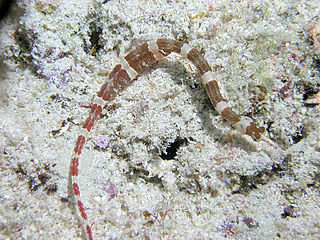
Corythoichthys amplexus, known commonly as the brown-banded pipefish, is a species of marine fish in the family Syngnathidae.
Choeroichthys latispinosus, also known as the Muiron Island pipefish or Muiron pipefish, is a species of pipefish native to the western coast of Western Australia, named for its recorded sighting on South Murion Island. It is thought to inhabit the area from Port Denison to Brecknock Island in the eastern Kimberley region.

Corythoichthys flavofasciatus, known commonly as the network pipefish, reticulate pipefish and yellow-banded pipefish, is a species of marine fish in the family Syngnathidae.
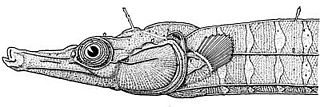
Cosmocampus albirostris is a marine fish of the family Syngnathidae. It is found in the western Atlantic Ocean, along the US coast from North Carolina to Florida, in the Gulf of Mexico, along the Yucatán Peninsula to Cuba, in the Caribbean from Puerto Rico to Grenada, and along Central and South America to southern Brazil. It lives among coral reefs, sea floor rubble, and sparse algae to depths of about 40 metres (130 ft), where it can grow to lengths of 20 centimetres (7.9 in). This species is ovoviviparous, with males carrying eggs in a brood pouch and giving birth to live young The Cosmocampus albirostris is a species of pipefish that has been historically collected in the State of Bahia. These species are in the Brazilian list of marine fishes that are authorized to be exported for ornamental purposes. This information was taken from a case study that monitored the ornamental trade of seahorses and pipefishes in Brazil, where harvesting of pipefish is common, and it was also discovered that Cosmocampus albirostris are predominantly harvested in reef areas.
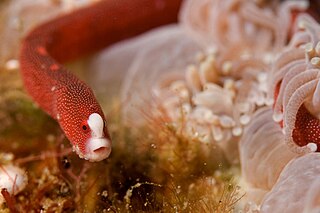
Bulbonaricus brauni is a species of marine fish of the family Syngnathidae. It is found in the Eastern Indian Ocean, from Indonesia to Western Australia, and off the Ryukyu Islands of Japan. It lives among coral reefs at depths of 1-10m, and can grow to lengths of 5.5 cm. This species is ovoviviparous, with the males carrying eggs in a brood pouch until they hatch. The specific name honours "the collector" Mr J. Braun who brought the living holotype to the Western Australia Museum.
Choeroichthys suillus is a species of marine fish of the family Syngnathidae. It is endemic to Australia, occurring from Perth, along northern Australia, to southern Queensland. It lives in coral reefs to a depth of 14 metres (46 ft), where it can grow to lengths of 6 centimetres (2.4 in). This species is ovoviviparous, with males carrying eggs and giving birth to live young. Within the reef it is found among coral rubble.
Cosmocampus balli is a species of fish of the family Syngnathidae. It is endemic to Hawaii, with observations off Oahu and Kauai. It lives is shallow, protected coral reef or rocky habitats, where it can grow to lengths of 7 centimetres (2.8 in). Although little is known about its feeding habits, it is expected to consume small crustaceans, similar to other pipefishes. This species is ovoviviparous, with males carrying eggs and giving birth to live young. Males can brood at 4.5 centimetres (1.8 in).
Cosmocampus darrosanus is a species of marine fish of the family Syngnathidae. It is found in the Western Indian Ocean, Sri Lanka, Indonesia, Guam, and the Great Barrier Reef (Australia). It lives in tidepools and coral reefs to depths of 3 metres (9.8 ft), where it can grow to lengths of 7.4 centimetres (2.9 in). This species is ovoviviparous, with males carrying eggs before giving birth to live young.
Cosmocampus elucens is a species of marine fish of the family Syngnathidae. It is found in the western Atlantic, off the U.S. east coast, Bermuda, the Bahamas, the Gulf of Mexico, throughout the Caribbean Sea, and off the coast of Brazil. It lives in seagrass and algae beds, typically at shallow depths, where it can grow to lengths of 15 centimetres (5.9 in). It is expected to feed on small crustaceans, similar to other pipefishes. This species is ovoviviparous, with males carrying eggs and giving birth to live young.
Cosmocampus heraldi is a species of marine fish of the family Syngnathidae. It is known from only seven specimens, which were found at the Desventuradas and Juan Fernandez Islands in Chile. It inhabits rocky reefs and sandy areas at depths of 6–23 metres (20–75 ft), where it can grow to lengths of 7 centimetres (2.8 in). It is expected to feed on small crustaceans like other pipefish. This species is ovoviviparous, with males carrying eggs until giving birth to live young.
Cosmocampus howensis is a species of marine fish of the family Syngnathidae. It is found in the South Pacific from Jervis Bay to Easter Island. It lives in lagoons and on rocky reefs, where it grows to lengths of 10–12 centimetres (3.9–4.7 in). It is expected to feed on small crustaceans, similar to other pipefishes. This species is ovoviviparous, with males carrying eggs before giving birth to live young.
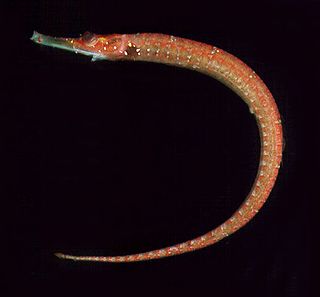
Cosmocampus maxweberi is a species of marine fish of the family Syngnathidae. It is found in the Red Sea from Sumatra to Tonga and Samoa, and from the Marshall Islands to the Great Barrier Reef. Adults live in reefs and reef-rubble to depths of 36 m, while planktonic juveniles have been found in the top 85m of 1500–2000 m water columns. Adults are expected to feed on small crustaceans, similar to other pipefish, and can grow to lengths of 10 cm. This species is ovoviviparous, with males carrying eggs until giving birth to live young.
Cosmocampus profundus is a species of marine fish of the family Syngnathidae. It is found near the southeastern US, the Virgin Islands, and the Yucatan Peninsula of Mexico. The few specimens of this species that have been collected were found over sand and coral at depths of 100-265m. This species is ovoviviparous, with males carrying eggs before giving birth to live young.

Doryrhamphus negrosensis, commonly known as Negros pipefish, flagtail pipefish, Masthead Island pipefish or Queensland flagtail pipefish, is a species of marine fish of the family Syngnathidae. It is found in the Western Pacific Ocean, from Borneo to Vanuatu and the Yaeyama Islands to the Rowley Shoals and the Great Barrier Reef. It lives in mud flats and reefs, both coral and rocky, where it is often associated with sea urchins. It is a rather solitary species which may be found in pairs or small groups. It inhabits depths to 9 metres (30 ft), and can grow to lengths of 6.2 centimetres (2.4 in). Although little is known of its feeding habits, it is expected to feed on harpacticoid copepods, gammarid shrimps, and mysids, similar to other pipefish, it may also act as a cleaner fish like other species in the genus Doryrhamphus. This species is ovoviviparous, with males carrying eggs before giving birth to live young. Males may brood at 4.3 cm. It is a small bluish to bluish-grey pipefish which has a pale stripe along the dorsal side of the head and snout, and a dark fan-like caudal fin which has white margins and an orange base.
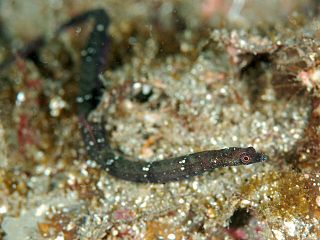
Booth's pipefish is a species of marine fish of the family Syngnathidae. It is found in the Western Indian Ocean, in South Africa and the Comoro Islands, and in the Western Pacific, from South Korea and Japan to the Great Barrier Reef and Tonga. It lives in rocks and coral reefs to depths of 30 metres (98 ft), where it can grow to lengths of 17.5 centimetres (6.9 in). This species is ovoviviparous, with males carrying eggs and giving birth to live young.

Halicampus brocki, the tasselled pipefish, or Brock's pipefish, is a species of marine fish of the family Syngnathidae. It is found in the Indo-Pacific, from southern Japan, Guam and the Marshall Islands to the central east and west coasts of Australia. It lives on coral and rocky reefs with algae, to depths of 45 metres (148 ft). It can grow to lengths of 12 centimetres (4.7 in), and is expected to feed on small crustaceans, similar to other pipefish. This species is ovoviviparous, with males carrying eggs and giving birth to live young.
Gray's pipefish, also known as the mud pipefish or spiny pipefish is a species of marine fish of the family Syngnathidae. It is found in the Indo-Pacific in the Gulf of Aden, Sri Lanka, and from the Gulf of Thailand to Japan, the Marshall Islands, and the Great Barrier Reef. It lives to depth of 100 metres (330 ft), and planktonic juveniles have been found above depths of 3,000 metres (1.9 mi). It occurs in muddy habitats, in estuaries, and on coral reefs, where it likely feeds on small crustaceans. It can grow to lengths of 20 centimetres (7.9 in). This species is ovoviviparous, with males carrying eggs in a brood pouch before giving birth to live young.

The Samoan pipefish, or brown pipefish, is a species of marine fish of the family Syngnathidae. It is found in the Indo-Pacific, from the Red Sea, to Sodwana Bay, to Taiwan, the Marshall Islands, and Samoa, where it inhabits tidepools and coral and rocky reefs to depths of 15 metres (49 ft). It is a solitary species with cryptic habits and is rarely observed. It is likely to feed on small crustaceans, and can grow to lengths of 14 centimetres (5.5 in). This species is ovoviviparous, with males carrying the fertilised eggs in a brood pouch, the folds of which fall well short of the centre of the egg-filled pouch, eventually giving birth to live young.
The glittering pipefish is a species of marine coastal fish of the family Syngnathidae. It is found in the Western Pacific, from Viet Nam to Fiji and from the Ryukyu Islands to New Caledonia, where it inhabits corals, sand and reef flats to depths of 20 metres (66 ft).< It can grow to lengths of 7.3 centimetres (2.9 in), and is expected to feed on small crustaceans, similar to other pipefishes. It is secretive and rarely observed. This species is ovoviviparous, with males carrying eggs and giving birth to live young.











